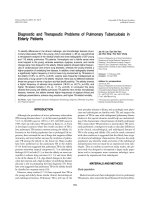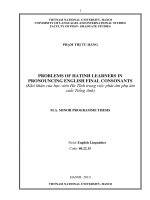Problems of cotton farmers in Haryana
Bạn đang xem bản rút gọn của tài liệu. Xem và tải ngay bản đầy đủ của tài liệu tại đây (199.91 KB, 4 trang )
Int.J.Curr.Microbiol.App.Sci (2019) 8(3): 2139-2142
International Journal of Current Microbiology and Applied Sciences
ISSN: 2319-7706 Volume 8 Number 03 (2019)
Journal homepage:
Original Research Article
/>
Problems of Cotton Farmers in Haryana
Reeta Devi Yadav* and Rita Goel
Department of Extension Education and Communication Management, I.C. College of Home
Science, CCSHAU, Hisar, Haryana, India
*Corresponding author
ABSTRACT
Keywords
Cotton cultivation,
Farmer’s problem,
Seeds, Haryana
Article Info
Accepted:
18 February 2019
Available Online:
10 March 2019
Cotton the “white gold” is premier industrial crop of major cotton growing countries like
China, India, United States of America, Pakistan, Brazil, Uzbekistan, Egypt, Argentina,
Australia and Turkey which accounts for nearly 85 per cent of the total global production.
Apart from the increasing production of synthetic fibre, cotton has maintained its
reputation as “king of the fibre crops”. It is world’s most important textile fibre and oil
seed crop. The present study was conducted in Sirsa and Fatehabad district of Haryana
state, purposively in the year 2015-16. Two blocks viz. Nathusari Chopta and Sirsa from
Sirsa district and Bhuna and Bhattukalan from Fatehabad district were selected
purposively. From each block one village was selected randomly and fifty farm families
from each village were selected, thus making 200 families and total 400 respondents
(husband and wife from each family). Interview schedule was used and data were collected
personally, frequency and percentage were used to interpretation and analysis. Data
regarding problems faced by respondents in cotton cultivation were climatic, seeds,
fertilizer, irrigation, plant protection, shortage of labour and marketing. From climatic
problems, unexpected rain (98.0%) followed by outbreak of pests/diseases (94.0%),
regarding problem of seed majority of respondents had faced the problem of adulterated
seed (93.0%) and high cost of seed (83.5%), while non-availability of seeds reported by
30.0 per cent of the respondents. High cost of fertilizer as their major problem (99.0%),
high cost of pesticides and chemicals (99.0%), adulteration (82.0%), high cost of labour
wages (77.5%) majority had reported very less MSP (98.0%) followed by low rate of
return (96.0%) respectively.
Introduction
Cotton the “white gold” is premier industrial
crop of major cotton growing countries like
China, India, United States of America,
Pakistan,
Brazil,
Uzbekistan,
Egypt,
Argentina, Australia and Turkey which
accounts for nearly 85 per cent of the total
global production. Apart from the increasing
production of synthetic fibre, cotton has
maintained its reputation as “king of the fibre
crops” (Shiv Kumar, 2007). It is world’s most
important textile fibre and oil seed crop. The
share of Haryana in area and production of
cotton in India was 6.14 lakh hectares and
24.00 lakh bales respectively during the year
2010-13. India also exported 4.58 lakh tones
of cotton worth Rs.2866 crore in 2011-12
2139
Int.J.Curr.Microbiol.App.Sci (2019) 8(3): 2139-2142
(Anonymous, 2012). In 2011-12, it was
cultivated on about 12.19 million hectares
producing 35.3 million bales. In last ten years,
cotton acreage has been growing at an
average annual rate of around 3.00 per cent.
However, the average cotton yield in India is
only 0.49 tons per hectares compared to world
average of 0.73 tons per hectare (International
Cotton Advisory Committee, 2010). In the
subsequent year the cotton area and
production shrunken to 11.77 million hectare
and
34
million
bales
respectively
(Anonymous, 2013). The low yields of cotton
in India are attributed to inadequate input
usage, rain fed cultivation, untimely
operations on field and inefficient crop
production technologies (Majumdar, 2012).
The low yields persistent in Indian cotton
production are also attributed to the lack of
disease resistant and high yielding varieties.
Another factor affecting the yield is rainfall
pattern in India. About 65.00 per cent of the
cotton acreage in India is dependent on rain;
the annual variation in monsoon rainfall plays
an important role in production and yield for
any particular year (Aggarwal, et al., 2008).
Thus, keeping in view the low production and
productivity of cotton crop, the study was
carried out with the objective of problems
faced by cotton farmers in Haryana.
Materials and Methods
Present study was conducted in Sirsa and
Fatehabad district of Haryana state,
purposively in the year 2015-16. Two blocks
viz. Nathusari Chopta and Sirsa from Sirsa
district and Bhuna and Bhattukalan from
Fatehabad district were selected purposively.
From each block one village was selected
randomly and fifty farm families from each
village were selected, thus making 200
families and total 400. Interview schedule was
used and data were collected personally,
frequency and percentage were used to
interpretation and analysis.
Results and Discussion
Cotton varieties and their production
potential
Data presented in Table 1 revealed the
information regarding cotton varieties grown
and the production potential of the varieties as
perceived by respondents. Cent percent
respondents had grown Bt cotton, while 12.5
per cent had also grown Desi cotton.
Regarding production potential, majority of
the respondents (72.50%) had perceived yield
7.5 to 11 quintal/acres, followed by 19.5 per
cent had perceived 4 to 7 quintal/acre yield
and 8.0 per cent had perceived 11.5 to 15
quintal/acre yield for Bt cotton. The
production potential for Desi cotton 11.0 per
cent had perceived 3.5 t 5 quintal/acre yield
and only 1.5 per cent had perceived 5.5 t 8
quintal/acre yield.
Problems of farmers were studied in terms of
climatic, seeds, fertilizer, irrigation, plant
protection, shortage of labour and marketing
in cotton cultivation and presented in Table 2
as follows; Climatic problems as perceived by
respondents,
majority
had
reported
unexpected rain (98.0%) followed by
outbreak of pests/diseases (94.0%). Regarding
problem of seed majority of respondents had
faced the problem of adulterated seed (93.0%)
and high cost of seed (83.5%), while nonavailability of seeds reported by 30.0 per cent
of the respondents. Table 2 further elucidated
information regarding fertilizer majority of
the respondents had reported, high cost of
fertilizer as their major problem (99.0%)
followed by lack of knowledge about correct
dose (31.0%), while 8.5 per cent had reported
non-availability of fertilizer as their problem.
Regarding problem of irrigation, water
shortage in canal was reported by 62.5 per
cent of the respondents. Data presented in
Table 2 pinpointed that high cost of pesticides
and chemicals (99.0%), adulteration (82.0%),
2140
Int.J.Curr.Microbiol.App.Sci (2019) 8(3): 2139-2142
lack of knowledge about correct dose (54.5%)
and non- availability of pesticides (38.0%)
were the problems of plant protection as
perceived by respondents. Further it was
evident from the Table 2 that high cost of
labour wages (77.5%) and shortage of labour
(55.5%) were also the problem in cotton
cultivation. Problems faced by respondents
regarding marketing of cotton majority had
reported very less MSP (98.0%) followed by
low rate of return (96.0%) and heavy price
fluctuation (32.5%) respectively.
Table.1 Varieties and their production potential of cotton perceived by respondents n=400
S.N.
1.
2.
Varieties
Bt
Yield/acre (in quintals)
4 to 7
7.5 to 11
11.5 to 15
Desi
Yield/acre (in quintals)
3.5 to 5
5.5 to 8
f
400
(%)
100.00
78
290
32
50
19.50
72.50
8.00
12.50
44
6
11.00
1.50
Table.2 Problems in cotton cultivation n=400
S.No.
1.
Topic
Climatic
2.
Seeds
3.
Fertilizer
4.
5.
Irrigation
Plant protection
6.
Labourer
7.
Marketing
Constraints
Unexpected rain
Outbreak of pests /diseases
High cost of seed
Non-availability of seeds
Adulterated seeds
Non-availability of fertilizer
High cost of fertilizer
Lack of knowledge about correct dose
Water shortages in canal
High cost of pesticide/chemicals
Lack of knowledge about correct dose
Adulteration
Non availability
Shortage of labour
High cost /wages
Heavy price fluctuation
Very less Minimum Support Price (MSP)
Low rate of return
f (%)*
392(98.0)
376 (94.0)
334 (83.5)
120 (30.0)
372 (93.0)
34 (8.50)
396 (99.0)
124 (31.0)
250 (62.5)
396 (99.0)
218 (54.5)
328(82.0)
152(38.0)
222 (55.5)
310 (77.5)
130 (32.5)
392 (98.0)
384 (96.0)
*Multiple responses
Findings were in line with those of Mondal and
Sinha (2015) that the problems faced by the
cotton growers were endemic to pest and
diseases, soil problems, effect of insecticides,
drought and late heavy rainfall, labour
problems, black marketing and private traders.
2141
Int.J.Curr.Microbiol.App.Sci (2019) 8(3): 2139-2142
Similar findings were reported by Maraddi et
al., (2004), Reddy et al., (2010), Kumar et al.,
(2012) and Singh et al., (2013).
In conclusion, cotton is world’s most important
textile fibre and oil seed crop. For Indian farmer
it is important cash crop, which is input and
labour intensive. In the cotton crop farmers
dependency increasers upon the seed companies
due to the reason of growing Bt cotton. For
every next crop farmers have to purchase seeds
form the large companies, which ultimately
reduces their profit margin. Our farmers are
facing various constraints with regard to
climatic conditions such as unexpected rain,
outbreak of pest/diseases, seed related problems
including adulterated seeds, high cost of seeds
and non-availability of seeds. High cost of
fertilizers, pesticides, and high cost of labour
wages and less MSP and low rate of returns
were also reported by the farmers. In order to
sustain the optimum production and the
productivity of soil, scientific and indigenous
methods should be synergies together and
policy intervention is utmost important for the
farmers well being.
References
Aggarwal, P.K., Hebbar, K.B., Venugopalan,
M.V., Rani, S., Bala, A., Biswal, A. and
Wani S.P. 2008. Quantification of Yield
Gap in Rain-fed Rice, Wheat, Cotton and
Mustard in India. Global Theme on
Agroecosystems.
Report
no.43
International Crops Research Institute for
the Semi-Arid Tropics, India.
Anonymous, 2012. Statistical Abstract of
Haryana,
2010-2011.
Issued
by
Department of Economic and Statistical
Analysis, Haryana
Anonymous. 2013. Oversupply triggers price
war among Bt hybrid cotton seed maker.
/>market/oversupply-triggers-price-waramong-bt-hybrid-cotton-seed-makers978.php
International Cotton Advisory Committee
(ICAC). 2010. Outlook for World Cotton
Supply and Use, Eurocotton, 49th General
Assembly, June 2010, Paris, France.
Majumdar, G. 2012. Mechanization of Cotton
Production in India, CICR Technical
Bulletin, Central Institute of Cotton
Research, Nagpur, India.
Maraddi, G. N., Hirevenkanagoudar, L. V.,
Verma, N. S. and Halakeri, A. V. 2004.
The constraints in the adoption of cotton
production technologies in Malaprabha
command
area
of
Karnataka.
International symposium on “Strategies
for Sustainable Cotton Production” A
Global Vision, Univ. Agric. Sci. Dharwad,
Karnataka, India.
Mondal, D. and Sinha, S.K. 2015. Comparative
analysis of the problems faced by the
cotton growers in Gujarat. Journal of
Cotton Research Development. 29 (1)
167-171
Reddy, K.G., Reddy, M.C., Reddy, D.V. and
Kumar, S.R. 2010. Social Dynamics of
cotton farmers in distress areas: A case of
Andhra Pradesh. Journal of Cotton
Research Development. 24 (2) 270-274
Shiv Kumar, C.L. 2007. An Economic Analysis
of Production & Marketing of Bt Cotton
in Haryana and Karnataka. M.Sc. Thesis
CCS Haryana Agricultural University,
Hisar, Haryana
Singh, S., Kingra, H.S. and Singh, R. 2013.
Input Utilization and constraints of cotton
production in Punjab. Journal of Cotton
Research Development. 27 (1) 144-148.
How to cite this article:
Reeta Devi Yadav and Rita Goel. 2019. Problems of Cotton Farmers in Haryana.
Int.J.Curr.Microbiol.App.Sci. 8(03): 2139-2142. doi: />
2142









